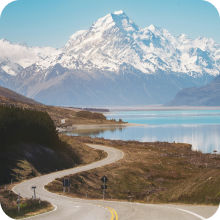Europe Itinerary Ideas For 4 Weeks
Europe - a continent that is a melting pot of cultures, languages, and history, teeming with majestic landscapes, delectable cuisine, art, and architecture. If you're planning a month-long expedition to this diverse continent, this guide will help you navigate through the labyrinth of choices. With 44 nations each offering a unique blend of history, culture, and natural beauty, we aim to help you craft the perfect 4-week Europe itinerary. So, put on your explorer's hat, and let's embark on this virtual journey.
Jetting off to Europe soon? Don't leave without checking out our eSIM Europe, designed for hassle-free travel connectivity
Table of Contents
Understanding Europe's Geography
Before we dive into our itinerary, let's get acquainted with the geography of Europe. Often, it's divided into four distinct regions - Western, Central, Eastern, and Southern. Each region offers its distinct charm and experiences.
Western Europe
Think of Western Europe and images of the Eiffel tower, Big Ben, and the beautiful Rhine river spring to mind. Home to countries like France, Germany, the Netherlands, and the United Kingdom, this region is renowned for its cosmopolitan cities, historic landmarks, and delectable cuisine.
Central Europe
Central Europe, on the other hand, is an architectural paradise steeped in history. Countries like Poland, Hungary, Austria, and the Czech Republic boast stunning castles, captivating medieval towns, and vibrant festivals.
Eastern Europe
Eastern Europe, comprising countries like Romania, Bulgaria, and Estonia, is the road less traveled. This region, rich in cultural heritage, offers unique off-the-beaten-path experiences, providing a fascinating insight into the ancient traditions and lifestyles.
Southern Europe
Southern Europe, which includes Spain, Italy, and Greece, among others, is synonymous with sunshine, stunning coastlines, delicious cuisine, and a laid-back lifestyle.
Plan According to Your Interest
One of the keys to an unforgettable European adventure is tailoring your trip to your interests. Whether you're a history buff, a food connoisseur, an adrenaline junkie, or a nature lover, Europe has something for everyone.
History & Culture
Europe's history is rich, diverse, and omnipresent. Immerse yourself in Europe's fascinating past and vibrant culture by visiting its numerous UNESCO World Heritage Sites, museums, historical landmarks, and soaking up the local customs and festivals.
Food & Wine
The culinary landscape of Europe is as diverse as its culture. Each region has its unique specialties - be it the delicate flavors of French cuisine, the hearty meals of Germany, the exotic spices of Hungarian dishes, or the delectable pasta and pizzas of Italy. Not to mention, Europe is the birthplace of some of the world's finest wines.
Adventure
For thrill-seekers, Europe offers a plethora of adventure sports and activities. Whether it's hiking through the rugged landscapes of the Scottish Highlands, skiing down the Alps, surfing the waves in Portugal, or cycling through the idyllic countryside of France, the choices are limitless.
Nature & Landscapes
From the serene fjords of Norway, the breathtaking cliffs of Moher in Ireland, to the pristine beaches of Greece, and the magnificent Swiss Alps, Europe's natural landscape is strikingly beautiful and diverse.

A Sample 4-week Europe Itinerary
Now that we've covered the broad strokes let's dive into a sample 4-week itinerary, guiding you through an unforgettable European journey.
Week 1: Western Europe
Begin your journey in the bustling city of London, soaking in its rich history and cosmopolitan charm. Then, take the Eurostar to Paris, the city of love, known for its art, fashion, and gastronomy. After spending a few days here, travel to Brussels, a city known for its medieval grandeur before rounding off your first week in Amsterdam, the city of canals.
Week 2: Central Europe
Start your second week in the vibrant city of Berlin, a city steeped in history yet buzzing with modernity. From there, head to Prague, the city of a hundred spires, before ending the week in Vienna, the city of music, known for its imperial palaces and stunning architecture.
Week 3: Eastern Europe
Kick start your third week in Budapest, known for its thermal baths and stunning architecture. Travel from there to Bucharest, where you'll get a taste of Romanian culture and history. Round off the week by exploring Sofia's rich history in Bulgaria.
Week 4: Southern Europe
Begin your final week in Rome, Italy's capital known for its art, architecture, and vibrant street life. Make your way to Barcelona, Spain, famed for its unique architecture and vibrant food scene. Conclude your grand tour in Athens, Greece, the cradle of Western civilization.
Tips for Traveling in Europe
To make the most out of your trip, here are a few tips:
Pack Light
Packing light can save you from a lot of hassle. Remember, Europe is known for its cobblestone streets and narrow staircases which can be hard to navigate with large suitcases.
Use Public Transportation
Public transport in Europe is extensive, efficient, and affordable. It's an excellent way to explore the cities while also being environmentally friendly.
Respect Local Cultures
Respecting local cultures and customs is essential. Always try to learn a few phrases in the local language, adhere to local etiquette, and be mindful of cultural sensitivities.
Planning a 4-week itinerary for Europe may seem daunting, given its rich diversity and the sheer number of attractions. However, with careful planning, prioritizing your interests, and balancing your time, you can make the most out of your journey, creating memories that will last a lifetime. So, pack your bags, open your mind, and embark on the journey of a lifetime.
Thanks for visiting our blog, are you planing to travel to Europe? Check out our Europe SIM card before you take off.
Before you take off make sure to check with local government of the travel status.
FAQs
-
What's the best time to visit Europe?
Europe can be visited all year round. However, spring (April-June) and fall (September-November) generally offer mild weather and fewer tourists.
-
Do I need a visa to travel in Europe?
It depends on your nationality. It's always best to check with the consulates of the countries you plan to visit for up-to-date visa information.
-
What's the most common language spoken in Europe?
While Europe is a melting pot of languages, English is widely understood in most regions.
-
What's the currency in Europe?
The Euro is the most commonly used currency, but some countries, particularly those outside the European Union, still use their national currencies.
-
Is Europe safe for travelers?
Yes, Europe is generally very safe for travelers. Nonetheless, it's always best to be aware of your surroundings, especially in larger cities, and take standard safety precautions.









